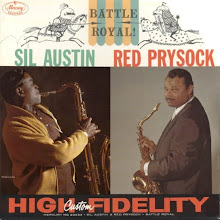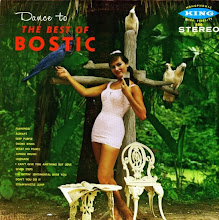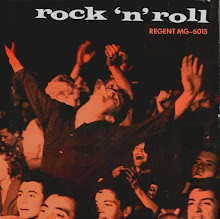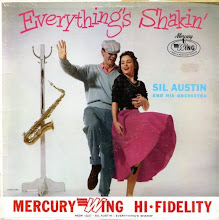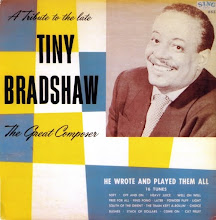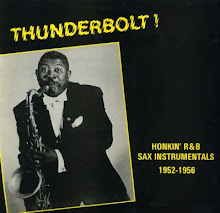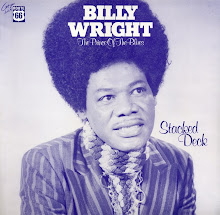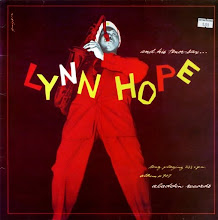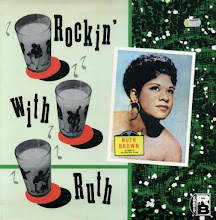Side 1:
01. Teardrops From My Eyes
02. 5-10-15 Hours
03. Daddy Daddy
04. Mama, He Treats Your Daughter Mean
05. Wild Wild Young Men
06. Love Contest
07. Hello Little Boy
08. Oh, What A Dream
Side 2:
01. Somebody Touched Me
02. Bye Bye Young Men
03. I Can See Everybody's Baby
04. As Long As I'm Moving
05. This Little Girl's Gone Rockin'
06. I Can't Hear A Word You Say
07. Papa Daddy
08. Don't Deceive Me
Note: download includes bonus folder of label scans from Joan. "Rockin' With Ruth" was originally posted on this blog on the
9th March 2010. This re-up has new cover and label scans. The archive is a Zip file generated by PeaZip. Some downloaders have been unable to open the RAR archive files since WinRAR was updated, so I thought I would try an alternative archiver. Please let me know if there are any problems.
This post started as a response to a re-up request but just kinda grew and grew. Here we go -
Ruth Brown - The Atlantic Years
Ruth Brown's massive record sales helped establish Atlantic as the top R&B label of the 1950s, so much so, that Atlantic was sometimes referred to as "The House That Ruth Built." Her best selling years were from 1951 - 1954, although she continued to have R&B chart entries (and some pop hits too) until 1960.
She was born Ruth Weston in Portsmouth, Virginia, on January 12th 1928. "Brown" was the surname of her first husband, trumpet player Jimmy Brown, whom she married early in her career. Like many R&B artists, Ruth's earliest exposure to music came through the church, in Ruth's case through the different styles of music in two churches - the organ / piano accompanied music of the African Methodist Episcopal church of which her father was a member, and the acapella singing of the North Carolina Baptist church to which her mother's family belonged.
Her father sang in the church choir and played the piano at home where family singsongs would consist mainly of sacred songs and old fashioned sentimental (and 100% "clean") pop songs. When a teenage Ruth started to get gigs singing blues songs at local clubs and USO venues, she had to "sneak out" to perform. Her most spectacular feat of fooling her parents came in 1944 when she took a bus to New York under the pretext of visiting her uncle but in reality with the intention of entering the amateur night at the Apollo, which she won.
Once she had graduated from high school Ruth was in a position to be more open about her musical ambitions and took gigs from bigger and more distant venues. It was while performing at a club in Detroit that she was spotted by bandleader Lucky Millinder and it seemed that her big break had arrived when he signed her as a vocalist for his band. The big break proved to be illusory as he already had a strong female vocalist in Anisteen Allen, and Ruth was fired on the flimsiest of pretexts after singing at just one gig in Washington D.C.
Left stranded by Millinder, Ruth had the good luck to get an audition for former bandleader Blanche Calloway, the older sister of Cab, who was running a Washington club called the Crystal Caverns. Blanche was impressed enough to offer young Ruth a temporary spot at the club to help her get back on her feet and back home. This was the real career break for Ruth, because her performances went down so well that word got to Ahmet Ertegun and Herb Abramson at Atlantic Records. The two diskery honchos made the trek to Washington and were impressed enough to offer Ruth the chance to sign up to what was still a pretty small recording company without a hit record to its name.
Blanche Calloway who had become Ruth's manager phoned the Apollo Theater in New York and arranged an appearance for her new client with the Dizzy Gillespie Orchestra, and so in October 1948 Ruth set out by car for NYC to appear at the premier black entertainment venue and to record for Atlantic. She made it as far as Chester, Pennsylvania, when the car crashed and Ruth wound up in hospital for months. She was still in crutches when she made her delayed recording debut in April 1949 at a session credited to Texas Johnny Brown, who was backed by Amos Milburn and his band. Ruth sang one track, "Rain Is a Bringdown" which was unreleased until it appeared many years later on a Route 66 LP.
Ruth's recording debut proper came on May 25th, 1949 when she cut "So Long," a tear-jerking ballad previously popularized by Little Miss Cornshucks. Coupled with "It's Raining," it was a hit, reaching number six in the Billboard R&B chart. This was the second hit that Atlantic had produced as earlier in the month Stick McGhee and His Buddies had stormed to number 3 in the charts with "Drinkin' Wine Spo-Dee O-Dee."
The follow up, another sentimental ballad, "I'll Get Along Somehow," was another success in late 1949, but in October 1950 Ruth recorded the side which really propelled Atlantic to its position as number 1 R&B label, the rocking Rudy Toombs composition, "Teardrops From My Eyes" which was her first number 1 R&B hit. It was the second highest selling single of 1951 (behind "Sixty Minute Man" by The Dominoes). The following release, "I'll Wait For You," reached number 8 in the R&B chart in March 1951, while "Teardrops From My Eyes" was still high in the same chart at number 5.
Her next release, "I Know," reached number 7 in August 1951, then in the spring of 1952 came another massive hit, the Rudy Toombs stomper "5 - 10 - 15 Hours." Backed by the sinuous sax of her second husband, Willis Jackson, Ruth's raunchy performance was a mile and more away from her early ballad successes.
The follow-up, "Daddy Daddy" another Rudy Toombs composition, which was much more explicit in its expression of lustful longing, also featured sax by Willis Jackson but somehow lacked the appeal of "5 - 10 - 15 Hours" and stalled at number 5 in the charts in October 1952. Thanks to the sales of records by The Clovers, Ruth Brown and Joe Turner, Atlantic was the top selling R&B label again in 1952.
In early 1953 Ruth was back at the top of the R&B chart with "(Mama) He Treats Your Daughter Mean," a disc which sparked a slew of answer discs by other artists. Ruth's next disc, the hard rocking "Wild, Wild Young Men" kept up the chart momentum, reaching number 3 at the end of June.
Ruth's autumn 1953 release, "The Tears Keep Tumbling Down" failed to chart nationally although it sold strongly in a few locations. This trend continued with Ruth's early 1954 releases - "Love Contest" sold well regionally but failed to crack the national charts, a reissue of a 1950 recording of "Sentimental Journey" with The Delta Rhythm Boys didn't do much while "Hello Little Boy" picked up some regional action in Chicago.
The second half of 1954 saw a revival in Ruth Brown's record sales, beginning with the Chuck Willis composition "Oh What A Dream" which reached number 1 in September. The follow up, "Mambo Baby" / "Somebody Touched Me" was released in October and reached number 1 in the R&B charts on November 20th, to give Ruth a successful close out to the year.
At this point, it's worth looking back over the years 1951 - 1954. In each of these years Ruth had finished in the top ten best selling R&B artist list. In 1951, '52 and '53 she was the top selling female R&B vocalist and in 1954 she came second to Faye Adams. In each of these years Atlantic was the top selling R&B label. In '51, '52 and '53 the top selling Atlantic act was The Clovers, and in '54 it was Clyde McPhatter and The Drifters, an indication that vocal groups were emerging as the most popular form of R&B. From the point of view of consistent record sales, these years were the most successful that Ruth would enjoy as the second half of the 1950's would prove to be much more uneven.

Above - Atlantic ad from January 1955. The old order changeth, giving way to the new. 1955 would bring great success to Ray Charles, LaVern Baker and Clyde McPhatter and The Drifters. Joe Turner continued to sell reasonably well, but it wasn't such a good year for Ruth Brown or for The Clovers. Ruth's January 1955 release of "Bye Bye Young Men" didn't chart but in April she had a double sided hit with "I Can See Everybody's Baby" reaching number 7 while the reverse side "As Long As I'm Moving" did even better, climbing to number 4 in the R&B chart.

She recorded some duets with Clyde McPhatter but only one of their collaborations was a good seller - "Love Has Joined Us Together" which was released in November 1955, made it to number 8 on the R&B chart. In 1956 Ruth could only scrape into the top fifty list of best selling R&B artists but 1957 brought an improvement with her recording of a jaunty Leiber - Stoller pop song, "Lucky Lips" which reached number 6 in the R&B chart and climbed to number 25 in the pop chart in March.
In 1958 a Leiber - Stoller production of the Bobby Darin penned "This Little Girl's Gone Rockin'" brought more pop success for Ruth, as it reached number 24 in the Billboard Hot 100 in October, and number 7 in the R&B chart. Ruth was now 30 years old so there was definitely something incongruous about her performance as a teenybopper telling her mama about the completion of her household chores before going out to sample the delights of rock and roll.
A Leiber - Stoller composition "Jack O'Diamonds" earned Ruth a number 23 R&B chart place in July 1959. It was essentially a pop production, with the superior (and very cynical) "I Can't Hear A Word You Say," which was reminiscent of Leiber - Stoller's material for The Coasters, relegated to the B-Side. Later in the year a fine bluesy production of "I Don't Know" reached number 5 in the R&B chart and number 64 in the Hot 100. A very convincing performance indeed
In April 1960 Ruth's recording of a Chuck Willis song "Don't Deceive Me," complete with string section and choir, made it to number 10 in the R&B chart and number 62 in the Hot 100 for Ruth's last chart hit on Atlantic.
Ruth's bluesy soulful vocals on "I Don't Know" and "Taking Care Of Business" (from September 1960) show a performer of great maturity and technique yet her career with Atlantic had stalled as far as chart action was concerned. In December 1959 Atlantic issued an LP of Ruth performing standards - "Late Date With Ruth Brown." With tasteful big band and string accompaniment, some tracks work well, while others don't. If more material like "I Don't Know" or "Taking Care Of Business" had been made available to Ruth then perhaps her Atlantic recording career wouldn't have petered out the way it did in the early '60's.
Cover shot from Discogs.com
In 1962 she left Atlantic and signed with Philips where she recorded "Along Came Ruth" - an album of cover versions of R&B hits such as "Sea Of Love" and "Cry Cry Cry." She also recorded an album of gospel songs but left the label sometime in 1963.
Ruth's career continued to decline and for some years was virtually dead as she took up jobs outside the music business in order to raise her sons and put them through university. However her fortunes began to revive in the 1980's with parts in stage shows "The Amen Corner," "Staggerlee" and the original Paris production of "Black and Blue." She was Motormouth Maybelle in John Waters' 1988 movie "Hairspray" and when "Black and Blue" opened on Broadway in January 1989 her comeback was complete - a Tony and a Grammy (for the original cast recording) followed.
When a lawyer fan learned that she was receiving no royalty payments from Atlantic (they claimed SHE owed them money) he took on her case and won substantial compensation not only for Ruth but for other surviving R&B veterans. This led to the setting up of The Rhythm and Blues Foundation, an organisation dedicated to the interests and welfare of a generation of forgotten (and often cheated) R&B performers.
Ruth Brown passed away in Las Vegas in November 2006 having suffered a heart attack and stroke.
The Facts On The Tracks on "Rockin' With Ruth"
"Teardrops From My Eyes" recorded in NYC in September 1950. Personnel: Ruth Brown (vocals) with: 2 unknown, trumpet; unknown, alto sax; Willis Jackson (tenor sax); probably Haywood Henry (baritone sax); unknown, piano, guitar, bass, drums; Budd Johnson (arranger).
Released in October 1950, b/w "Am I Making The Same Mistake Again" on Atlantic 919. Number 1 in the Billboard R&B chart for 11 weeks.
"5 - 10 - 15 Hours" recorded in NYC on February 13th, 1952. Personnel: Ruth Brown (vocals) with: unknown, trumpet; Willis Jackson (tenor sax); 2 unknown, saxes; Harry Van Walls (piano); unknown, guitar; unknown, bass; Connie Kay (drums).
Released in March 1952, b/w "Be Anything (But Be Mine)" on Atlantic 962. Number 1 in the Billboard R&B chart for 7 weeks.
"Daddy Daddy" was recorded in NYC on July 2nd, 1952. Personnel: Ruth Brown (vocals) with: Willis Jackson (tenor sax); unknown, cello; Harry Van Walls (piano); unknown, guitar; unknown, bass; unknown, drums; The James Quintet (vocal group).
Released in August 1952, b/w "Have A Good Time" on Atlantic 973. Number 5 in the Billboard R&B chart in October 1952.
"(Mama) He Treats Your Daughter Mean" was recorded in NYC on 19th December, 1952. Personnel: Ruth Brown (vocal) with: Taft Jordan (trumpet); Paul Williams (alto sax); Sam "The Man" Taylor (tenor sax); Jesse Stone (piano); Mickey Baker (guitar); Lloyd Trotman (bass); Connie Kay (drums); Hal Jackson (tambourine).
Released in January 1953, b/w "R.B. Blues" on Atlantic 986. Number 1 on the Billboard R&B charts for 5 weeks. 6th best selling R&B record of 1953.
"Wild Wild Young Men" was recorded in NYC on 10th April 1953. Personnel: Ruth Brown (vocals) with: Taft Jordan (trumpet); Freddie Mitchell (tenor sax); Haywood Henry (baritone sax); Harry Van Walls (piano); Rector Bailey (guitar); George Duvivier (bass); Connie Kay (drums); Jesse Stone (arranger).
Released in April 1953, b/w "Mend Your Ways" on Atlantic 993. Number 3 in Billboard R&B chart, 27th June 1953.
"Love Contest" was recorded in NYC on 16th December 1953. Personnel: Ruth Brown (vocals) with: Sam "The Man" Taylor (tenor sax); Paul Williams (baritone sax); Kelly Owens (piano); Mickey Baker (guitar); Lloyd Trotman (bass); Joe Marshall (drums); Jesse Stone (arranger).
Released in January 1954, b/w "You Don't Want Me" on Atlantic 1018.
"Hello Little Boy" was recorded at the same session as "Love Contest." Personnel as above except John Lewis replaces Kelly Owens on piano.
Released in April 1954, b/w "If I Had Any Sense" on Atlantic 1027.
"Oh What A Dream" was recorded in NYC on 7th May 1954. Personnel: Ruth Brown (vocals) with: Ed "Tiger" Lewis (trumpet); Richard Harris (trombone); Arnett Cobb (tenor sax); Sylvester Thomas (baritone sax); Bu Pleasant (piano); Mickey Baker (guitar); Benny Moten (bass); Noruddin Zafer (drums); The Rhythmakers (vocal group).
Released in July 1954, b/w "Please Don't Freeze" on Atlantic 1036. Number 1 in Billboard R&B chart, first two weeks of September 1954, 16 weeks in chart in total.
"Somebody Touched Me" was recorded at the same session as "Oh What A Dream." Personnel as above (the Arnett Cobb band plus The Rhythmakers vocal group).
Released in October 1954, B-Side of "Mambo Baby" on Atlantic 1044. "Mambo Baby" reached number 1 in the Billboard best selling R&B chart on 20th November 1954.
"Bye Bye Young Men" was recorded in NYC on 11th August, 1954. Personnel: Ruth Brown (vocals) with: unknown trumpet, tenor and baritone saxes, piano, bass and drums. The Rhythmakers (vocal group).
Released in January 1955 b/w "Ever Since My Baby's Been Gone" on Atlantic 1051.
"I Can See Everybody's Baby" and "As Long As I'm Moving" were recorded in NYC on 1st March 1955. Personnel: Ruth Brown (vocals) with: Sam "The Man" Taylor (tenor sax); The Rhythmakers (vocal group); rest unknown.
Released in April 1955, "I Can See Everybody's Baby" / "As Long As I'm Moving" on Atlantic 1059. "I Can See Everybody's Baby" reached number 7 on the Billboard R&B chart and "As Long As I'm Moving" reached number 4.
Above: 1955 Atlantic EP "Ruth Brown Sings."
"This Little Girl's Gone Rockin'" was recorded in NYC on 30th July 1958. Personnel: Ruth Brown (vocal) with: Joe Wilder, Steve Lipkin (trumpets); King Curtis (tenor sax); Mike Stoller (piano); Charles Macey, Everett Barksdale (guitars); Lloyd Trotman (bass); Joe Marshall (drums) Bradley Spirmer (percussion); unknown vocal group; Howard Biggs (arranger).
Released in August 1958, b/w "Why Me" on Atlantic 1197. Number 24 in the Billboard Hot 100 pop chart, October 1958 and number 7 in the R&B chart. "Why Me" reached number 17 in the Billboard Hot R&B Sides chart in November 1958.
"I Can't Hear A Word You Say" was recorded in NYC on 7th March 1959. Personnel: Ruth Brown (vocals) with: Jimmy Cleveland (trombone); King Curtis, Budd Johnson (tenor saxes); Ernie Hayes (piano); Bill Suyker, Wally Richardson (guitars); Earl Mays (bass); Sticks Evans (drums); Howard Biggs (arranger).
Released in May 1959, B-Side of "Jack O'Diamonds" on Atlantic 2026. "Jack O'Diamonds" was number 23 in the Billboard Hot R&B Sides chart in July 1959.
"Papa Daddy" was recorded at the same session as "I Can't Hear A Word You Say" with the same personnel.
Released in August 1959, B-Side of "I Don't Know" on Atlantic 2035. "I Don't Know" was number 5 in the Billboard Hot R&B Sides chart and number 64 in the Billboard Hot 100 in November 1959.
May 1959 compilation LP
"Don't Deceive Me" was recorded in NYC on 30th September 1959. Personnel: Ruth Brown (vocals) with: Sol Gubin (vibes); Mickey Baker, Mundell Lowe, Carl Lynch (guitars); Abie Baker (bass); Sticks Evans (drums); Elise Bretton, Jerome Graff, Bill Marine, Merrill Ostrus, Marcia Patterson, Nelson Starr, choir; 8 violins, 2 violas, 2 celli, Reggie Obrecht, Richard Wess, conductor.
Released in February 1960, b/w "I Burned Your Letter" on Atlantic 2052. Number 10 in the Billboard Hot R&B Sides chart and number 62 in the Billboard Hot 100 in April 1960.
Thanks to
Joan K for label scans and cover scans used throughout this post. Information sources include Billboard, The Cash Box, www.45worlds.com, www.discogs.com, www.jazzdisco.org, YouTube, Spotify, Bruyninckx discography, and most of all "Blue Rhythms: Six Lives In Rhythm And Blues" by Chip Deffaa, Da Capo Press, 2000 edition.








































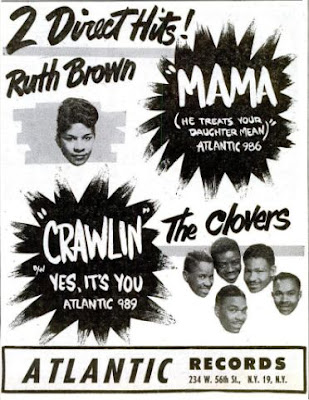











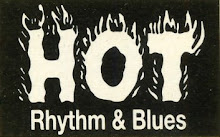
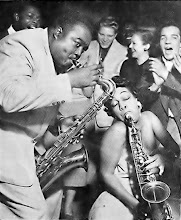





%2078%20-%204000B.png)

.jpg)
















